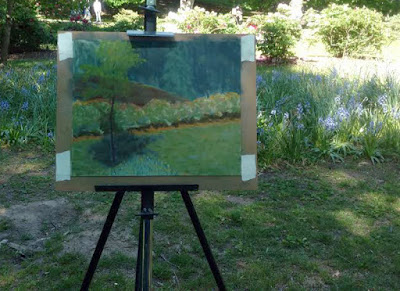This weekend’s workshop was all oil painters. This gave me the opportunity to review some fundamentals.
 |
| Nicole Reddington’s painting ruthlessly subjugated detail for design, and was tremendously powerful for that. I wish I had more student work to show you, but I can’t find my camera! |
Use enough paint
Using too little paint is a rookie error. Too little paint on your palette means you’ll try to stretch it with solvent on the bottom layers or medium on the top layers, and before you know it, you’re going to have a mushy, monochromatic mess on your hand. In the northeast, that soup usually assumes an unpleasant green tone.
Modern paints are formulated to use almost straight out of the tube. They may need a small amount of solvent for underpainting, or a dab of medium to create a juicy top layer, but too much of either ruins paintings.
In my weekly classes, I don’t let students touch painting medium until they have the steps of constructing a painting firmly in hand. That’s hard to do in a workshop, but remember that painting medium is a boost, not a crutch.
 |
| Sandy Quang’s painting of a downed tree. |
Big shapes to little shapes
Stop thinking of your value sketches as something you must get through before you get to the fun of painting. They’re the most important part of the process, and they’re also a lot of fun.
I like to do lots of preparatory sketches before I start to paint, either in marker or in monochromatic watercolor. The abstract pattern is far more important than the details. In the early phases of a painting, you must relentlessly sacrifice detail to the good of the whole. This is true whether the results you want are hyper-realistic or impressionistic.
The untrained eye looks at a scene and thinks about it piecemeal and in terms of objects: there’s a flower, there’s a path, there’s a tree. The trained eye sees patterns and considers the objects afterward.
Is there an interesting, coherent pattern of darks and lights? This pattern is the primary issue in composition.
| Stop thinking of drawing as something you have to get through, and start doing your dreaming in a sketchbook. |
Darks to light
In oils, it’s easy to paint into dark passages with a lighter color; the reverse isn’t true. Put down white paint too quickly, and you’re going to fight all afternoon to avoid fifty shades of meh.
This doesn’t mean oil painters don’t jump around after we set the darks; we can and do. But that dark pattern controls your paintings.
Don’t choose slow-drying or high-stain pigment to make your darks. The umbers are great because the manganese in them speeds drying. However, I don’t want to carry an extra tube just for this. I use a combination of burnt sienna and ultramarine.
| A student’s palette… This is the color space in which the modern painter can work. It sizzles. |
Fat over lean
Odorless mineral spirits (OMS) replaces turpentine as the modern solvent. This is different from medium, which is some combination of oil, drying agent, solvent and varnish. Paint with solvent in the bottom layers. Paint with medium in the top layers. As noted above, use both sparingly.
The more oil in a layer, the longer the binder takes to oxidize. This keeps paints brighter and more flexible. However, oil also retards drying. Using too much in underpainting will result in a cracked and crazed surface over time.
The makers of Galkyd and Liquin say their products are designed to circumvent this rule. However, we have no track record for these alkyd-based synthetic mediums, whereas we have centuries of experience layering the traditional way.
Even if we could change it, why would we want to? Underpainting with soft, sloppy medium gives soft, sloppy results. The coverage is spotty and thin. The traditional method is tremendously variable and gives great control. It just takes a little while to learn it properly.
Next up, a watercolor workshop aboard American Eagle, June 10-14, and my annual Sea & Sky workshop at Acadia National Park, August 5-10. Email me if you have any questions.







